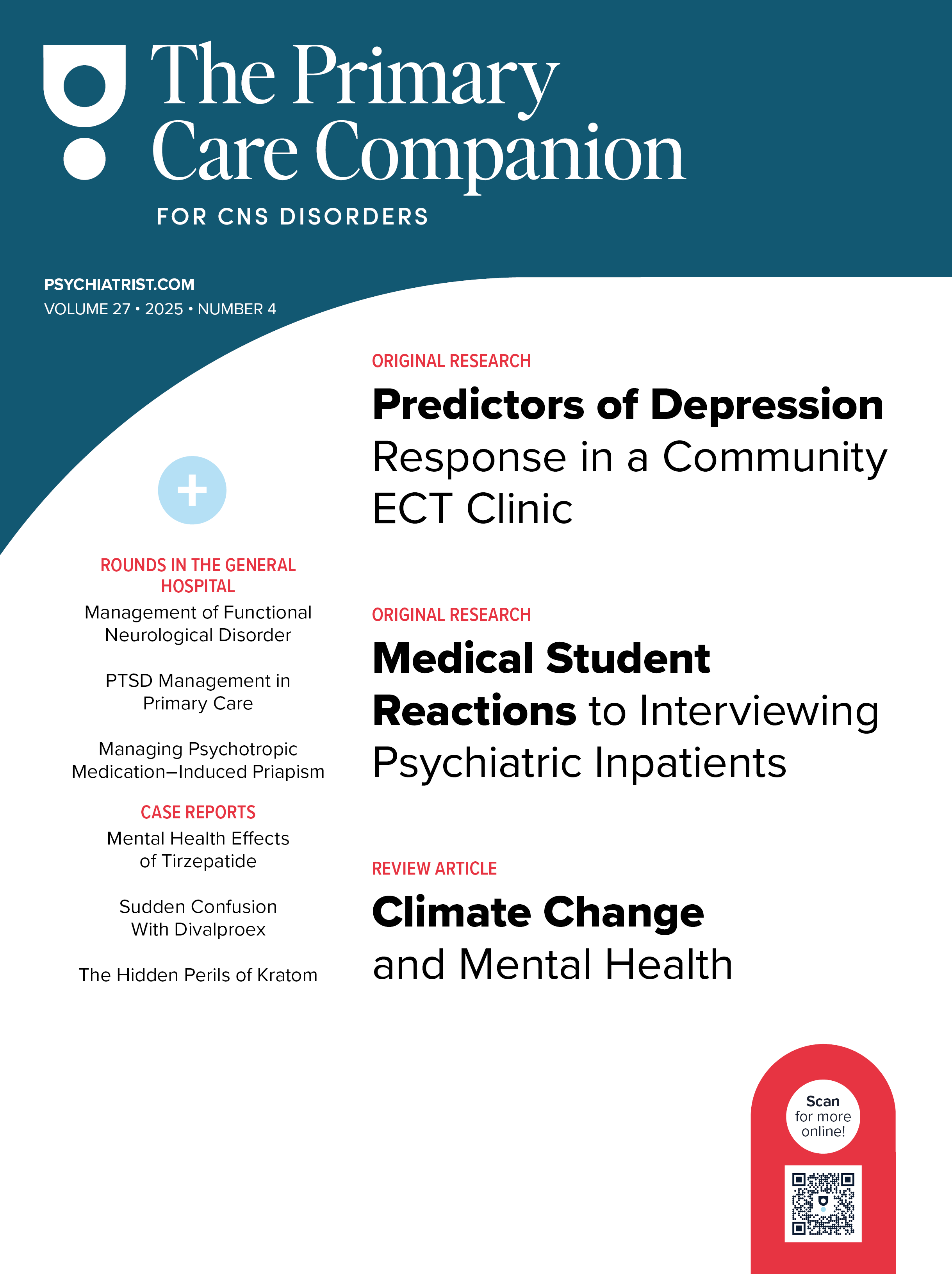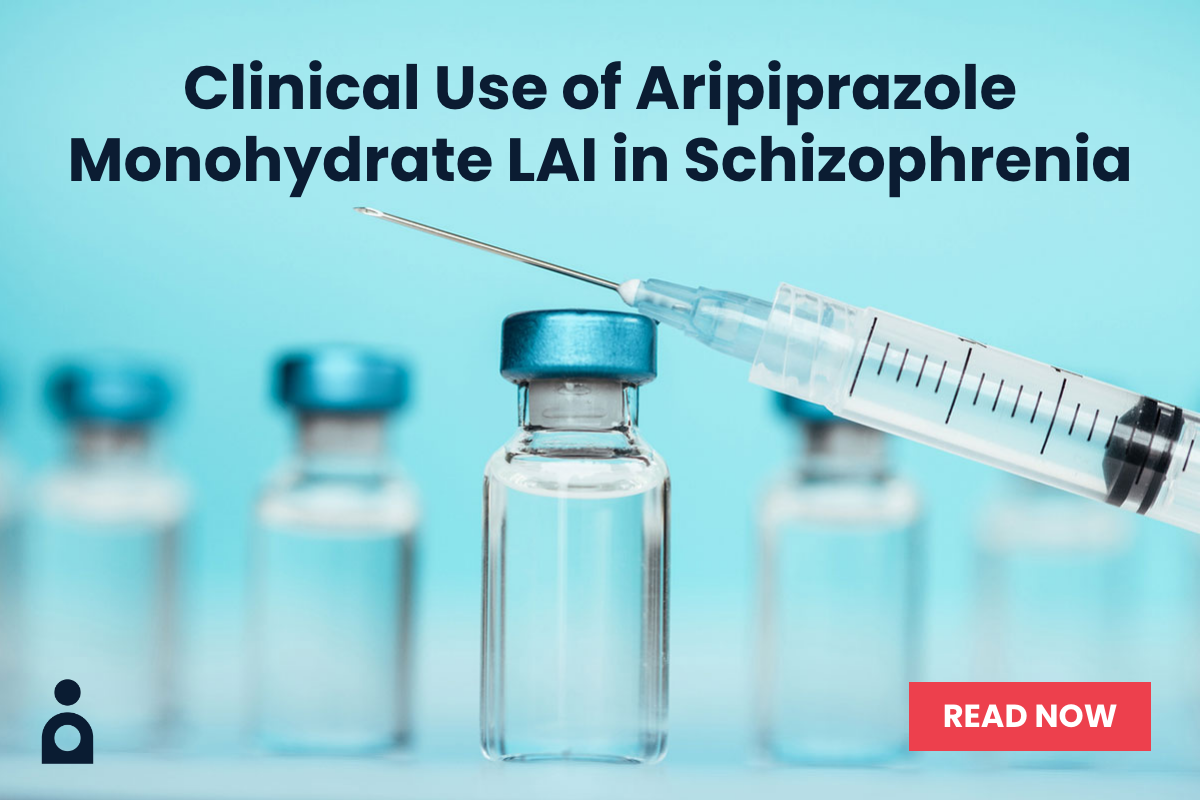Objective: To assess the effect of baseline body mass index (BMI) on efficacy and weight change in adults with major depressive disorder (MDD) treated with desvenlafaxine or placebo in a pooled, post hoc analysis.
Method: Adults with MDD were randomly assigned to placebo or desvenlafaxine (50 mg or 100 mg) in 8 short-term, double-blind studies and 1 longer-term randomized withdrawal study (the studies were published between 2007 and 2013). Change from baseline in 17-item Hamilton Depression Rating Scale (HDRS-17) total score at week 8 was analyzed in normal (BMI ≤ 25 kg/m2), overweight (25 kg/m2 < BMI ≤ 30 kg/m2), and obese (BMI > 30 kg/m2) subgroups using analysis of covariance (ANCOVA). Weight change was analyzed in BMI subgroups using ANCOVA and a mixed-effects model for repeated measures.
Results: Desvenlafaxine 50 mg/d or 100 mg/d improved HDRS-17 scores significantly from baseline to week 8 (last observation carried forward) versus placebo in all BMI subgroups (normal: n = 1,122; overweight: n = 960; obese: n = 1,302; all P ≤ .0027); improvement was greatest in normal BMI patients. There was a statistically significant decrease in weight (< 1 kg) with short-term desvenlafaxine 50 mg/d and 100 mg/d versus placebo in all BMI subgroups (all P < .0001). In the randomized withdrawal study (n = 548), no statistically significant difference in weight was observed for desvenlafaxine versus placebo in any BMI subgroup. Baseline BMI predicted weight change in short-term and longer-term desvenlafaxine treatment.
Conclusions: Desvenlafaxine significantly improved symptoms of depression versus placebo regardless of baseline BMI. In all BMI subgroups, desvenlafaxine was associated with statistically significant weight loss (< 1 kg) versus placebo over 8 weeks, but no significant differences longer term.
Trial Registration: ClinicalTrials.gov identifiers: NCT00072774, NCT00277823, NCT00300378, NCT00384033, NCT00798707, NCT00863798, NCT01121484, NCT00824291, NCT00887224
A Post Hoc Analysis of the Effect of Weight
on Efficacy in Depressed Patients Treated With
Desvenlafaxine 50 mg/d and 100 mg/d
ABSTRACT
Objective: To assess the effect of baseline body mass index (BMI) on efficacy and weight change in adults with major depressive disorder (MDD) treated with desvenlafaxine or placebo in a pooled, post hoc analysis.
Method: Adults with MDD were randomly assigned to placebo or desvenlafaxine (50 mg or 100 mg) in 8 short-term, double-blind studies and 1 longer-term randomized withdrawal study (the studies were published between 2007 and 2013). Change from baseline in 17-item Hamilton Depression Rating Scale (HDRS-17) total score at week 8
was analyzed in normal (BMI ≤ 25 kg/m2), overweight
(25 kg/m2 < BMI ≤ 30 kg/m2), and obese (BMI > 30 kg/m2) subgroups using analysis of covariance (ANCOVA). Weight change was analyzed in BMI subgroups using ANCOVA and a mixed-effects model for repeated measures.
Results: Desvenlafaxine 50 mg/d or 100 mg/d improved HDRS-17 scores significantly from baseline to week 8 (last observation carried forward) versus placebo in all BMI subgroups (normal: n = 1,122; overweight: n = 960; obese: n = 1,302; all P ≤ .0027); improvement was greatest in normal BMI patients. There was a statistically significant decrease in weight (< 1 kg) with short-term desvenlafaxine 50 mg/d and 100 mg/d versus placebo in all BMI subgroups (all P < .0001). In the randomized withdrawal study (n = 548), no statistically significant difference in weight was observed for desvenlafaxine versus placebo in any BMI subgroup. Baseline BMI predicted weight change in short-term and longer-term desvenlafaxine treatment.
Conclusions: Desvenlafaxine significantly improved symptoms of depression versus placebo regardless of baseline BMI. In all BMI subgroups, desvenlafaxine was associated with statistically significant weight loss (< 1 kg) versus placebo over 8 weeks, but no significant differences longer term.
Trial Registration: ClinicalTrials.gov identifiers: NCT00072774, NCT00277823, NCT00300378, NCT00384033, NCT00798707, NCT00863798, NCT01121484, NCT00824291, NCT00887224
Prim Care Companion CNS Disord 2015;17(3):doi:10.4088/PCC.14m01741
© Copyright 2015 Physicians Postgraduate Press, Inc.
Submitted: October 14, 2014; accepted February 19, 2015.
Published online: June 4, 2015.
Corresponding author: Roger S. McIntyre, MD, FRCPC, Department of Psychiatry and Pharmacology, University of Toronto and Mood Disorders Psychopharmacology Unit, University Health Network, 399 Bathurst St,
MP 9-325, Toronto, Ontario M5T 2S8, Canada ([email protected]).
The incidence of obesity is reported to be higher among depressed individuals than in the general population,1 but the nature of the relationship between body weight and depression is complex.2 Meta-analyses of prospective cohort3 and community-based studies4 suggest that obesity is associated with the development of depressive symptoms and, conversely, that depression predicts overweight and obesity. The foregoing observations were confirmed in an analysis specifically designed to assess the bidirectional relationship between body weight and depression using data collected over a 10-year period in the Nurses’ Health Study (N = 65,955 women)5: depression at baseline increased the odds of becoming overweight (adjusted odds ratio [95% CI]: 1.19 [1.13–1.24]) or obese (1.82 [1.73–1.92]), and baseline overweight (1.16 [1.11–1.21]) and obesity (1.63 [1.56–1.71]) were associated with an increased risk of depression over the 10-year period. The interaction between weight and depressive symptoms is further complicated by the effect of antidepressant treatment on body weight during acute and long-term treatment.6
While achievement of remission from depression is a primary consideration in treatment decisions for patients with major depressive disorder (MDD), the selection of an antidepressant without significant effect on weight, among medications with similar efficacy, is recommended—particularly in the treatment of patients who are overweight or obese.2,7 Weight change is a common concern during antidepressant treatment for MDD and can negatively affect adherence during long-term treatment.8 Moreover, patient weight or body mass index (BMI) at baseline may affect weight change during antidepressant treatment9,10 and also may influence the effectiveness of antidepressant drugs.11–14
Desvenlafaxine (administered as desvenlafaxine succinate) is a serotonin-norepinephrine reuptake inhibitor (SNRI) approved for the treatment of adults with MDD.15,16 Weight change during treatment with desvenlafaxine has been assessed at doses up to 400 mg/d; however, the relationship between baseline BMI and weight change during desvenlafaxine treatment has not been determined.17 The effect of baseline BMI on efficacy and weight during treatment with desvenlafaxine 50 mg/d and 100 mg/d, the doses approved for treatment of MDD, was therefore examined in this post hoc analysis of data from 8 short-term and 1 longer-term double-blind, placebo-controlled studies of patients with MDD.18–26 The primary objectives of the analysis were to assess the effect of baseline BMI on efficacy outcomes and weight change in adults with MDD treated with desvenlafaxine 50 mg/d or 100 mg/d versus placebo.
METHOD
Data Set
The post hoc analysis was conducted based on a preplanned statistical analysis plan. Patient-level data were pooled from 8 short-term, multicenter, randomized, double-blind, placebo-controlled fixed-dose studies of desvenlafaxine in MDD (published between 2007 and 2013; ClinicalTrials.gov identifiers: NCT00072774, NCT00277823, NCT00300378, NCT00384033, NCT00798707, NCT00863798, NCT01121484, NCT00824291).18–25 At the time these analyses were conducted, this study set comprised all available short-term, placebo-controlled studies in MDD conducted by the sponsor company (Pfizer) that included fixed-dose desvenlafaxine 50-mg or 100-mg treatment arms.
The pooled short-term studies were of similar design. Patients were randomly assigned to receive placebo or a fixed dose of desvenlafaxine (or duloxetine 60 mg/d in 1 trial21); data from placebo and desvenlafaxine 50-mg/d and 100-mg/d treatment arms only were included in this analysis. Six studies were 8 weeks in duration,18–23 1 study24 was 10 weeks in duration with a week 8 primary endpoint, and 1 study25 continued for 12 weeks. The primary efficacy outcome for each study was change from baseline in the 17-item Hamilton Depression Rating Scale27 (HDRS-17) total score at endpoint.
A 12-month, randomized withdrawal study (published in 2013; ClinicalTrials.gov identifier: NCT00887224)26 was analyzed separately for weight change only. The study consisted of a 20-week, open-label treatment period (8-week response phase + 12-week stability phase) and a 6-month, double-blind, placebo-controlled, randomized withdrawal period. All enrolled patients received 8-week, open-label treatment with desvenlafaxine 50 mg/d (response phase), and 8-week responders received open-label desvenlafaxine 50 mg/d for an additional 12 weeks (stability phase). Patients with continued stable response at open-label week 20 were randomly assigned to receive 6-month, double-blind treatment with placebo or desvenlafaxine 50 mg/d (1:1) after completion of the open-label period.
Patients
Enrollment criteria for patients in the studies in this analysis have been described previously.18–26 Briefly, all studies enrolled adult outpatients with a diagnosis of MDD consistent with criteria from the Diagnostic and Statistical Manual of Mental Disorders, Fourth Edition28 or the Diagnostic and Statistical Manual of Mental Disorders, Fourth Edition, Text Revision,29 with depressive symptoms for at least 30 days. Patients also met depression scale score criteria at screening and baseline (HDRS-17 total score ≥ 20 or Montgomery-Asberg Depression Rating Scale30 [MADRS] total score ≥ 25). Eight of the 9 studies enrolled male or female patients at least 18 years of age (or ≥ 20 years in Japan), with an upper age limit of 75 years in 1 study. One of the short-term studies24 enrolled perimenopausal and postmenopausal women only (aged 40 to 70 years). Exclusion criteria for each study were designed to select a sample of medically stable patients with a principal diagnosis of MDD (excluding bipolar and psychotic depression).
Assessments
The primary endpoint for the post hoc efficacy analysis was change from baseline in HDRS-17 total score. Other efficacy endpoints included change from baseline in MADRS total score and Clinical Global Impressions–Severity (CGI-S)31 and Sheehan Disability Scale32 (SDS) scores and change from baseline in the World Health Organization 5-item Well-Being Index33 (WHO-5; collected in 6 short-term studies). Rates of HDRS-17 response (defined as ≥ 50% reduction from baseline in HDRS-17 total score),34 HDRS-17 remission (HDRS-17 total score ≤ 7),35 MADRS response (≥ 50% reduction in MADRS total score),34 and MADRS remission (MADRS total score ≤ 10)36 were also determined.
Height was measured at the screening visit in all studies. In the short-term studies, weight was collected at baseline and weeks 1 (7 studies only), 2, 3 (6 studies), 4 (7 studies), 6, and 8. In the randomized withdrawal study, weight was collected at baseline and weeks 1, 2, 3, 4, 6, 8, 12, 16, and 20 (open-label phase) and weeks 21, 22, 23, 24, 26, 30, 34, 38, 42, and 46 (double-blind phase). Baseline BMI was calculated based on height at screening and weight at baseline visit.
Statistical Analysis
The post hoc efficacy analysis was based on the desvenlafaxine 50-mg/d and 100-mg/d and placebo arms in the pooled short-term studies only. The intent-to-treat (ITT) population was defined for the pooled studies as all patients who took at least 1 dose of study drug and had a baseline and at least 1 primary efficacy evaluation after the first dose of double-blind study drug.
Treatment effects on continuous efficacy outcomes were analyzed using an analysis of covariance (ANCOVA) model with treatment, study, and baseline in the model. Categorical outcomes were analyzed using logistic regression with study in the model. Three subgroups were defined on the basis of baseline BMI: normal (BMI ≤ 25 kg/m2), overweight (25 kg/m2 < BMI ≤ 30 kg/m2), and obese (BMI > 30 kg/m2). An underweight subgroup (BMI < 18.5 kg/m2) was collapsed into the normal group due to the low group sample sizes. Efficacy analyses were conducted for the overall pooled population and separately for the 3 baseline BMI subgroups. For all efficacy endpoints, the analysis was performed for each week using observed cases and at week 8 using the last observation carried forward (LOCF) approach for handling missing data, with the exception of the MADRS in the 12-week study. For that study, week 12 (LOCF) data were used because MADRS data were not collected at week 8. Baseline BMI (as a continuous variable) was also examined as a predictor of change from baseline in HDRS-17 total score using regression analysis, response and remission using logistic regression, and time to response (first week with ≥ 50% decrease in HDRS-17 total score) using Cox regression, assessed overall and for each treatment.
The effect of treatment on weight was analyzed using ANCOVA, with treatment, study, and baseline in the model, in the overall population and in the 3 baseline BMI subgroups. Weight change was assessed in the pooled short-term studies using observed cases data at weeks 1–4, 6, and 8 and at week 8 LOCF, and in the randomized withdrawal study double-blind phase at weeks 1–4, 6, 10, 14, 18, 22, and 26. The mean weight change over time was also assessed using a mixed-effects model for repeated measures. In the pooled studies, weight change at endpoint was summarized for HDRS-17 responders and remitters and for nonresponders and nonremitters.
Baseline BMI (as a continuous variable) was examined as a predictor of change in weight and BMI at week 8 (LOCF), overall and for each treatment, using regression analysis. The proportions of patients with clinically meaningful increases or decreases in body weight (≥ 7% change from baseline) were analyzed using Fisher exact test by BMI subgroup.
RESULTS
Patients
A total of 3,399 patients took at least 1 dose of study drug in the pooled, short-term studies and were included in the safety population for the pooled post hoc analysis. Of those, two-thirds were either overweight or obese at baseline: 1,131 (33.3%) had a BMI in the normal (or underweight) range; 964 (28.4%) were overweight; and 1,304 (38.4%) were obese. A total of 3,384 patients in the pooled studies (1,122 normal; 960 overweight; and 1,302 obese) had at least 1 postbaseline primary efficacy assessment and were included in the ITT population. The randomized withdrawal study enrolled 874 patients in the 20-week open-label phase (normal BMI: n = 345 [39.5%], overweight: n = 271 [31.0%], obese: n = 258 [29.5%]); 548 patients were randomized in the subsequent 6-month, double-blind phase, and 542 had at least 1 on-therapy weight assessment in the double-blind phase and were included in the weight change analysis. Baseline demographic and clinical characteristics were generally similar between treatment groups in the pooled short-term studies and the randomized withdrawal study (Table 1).
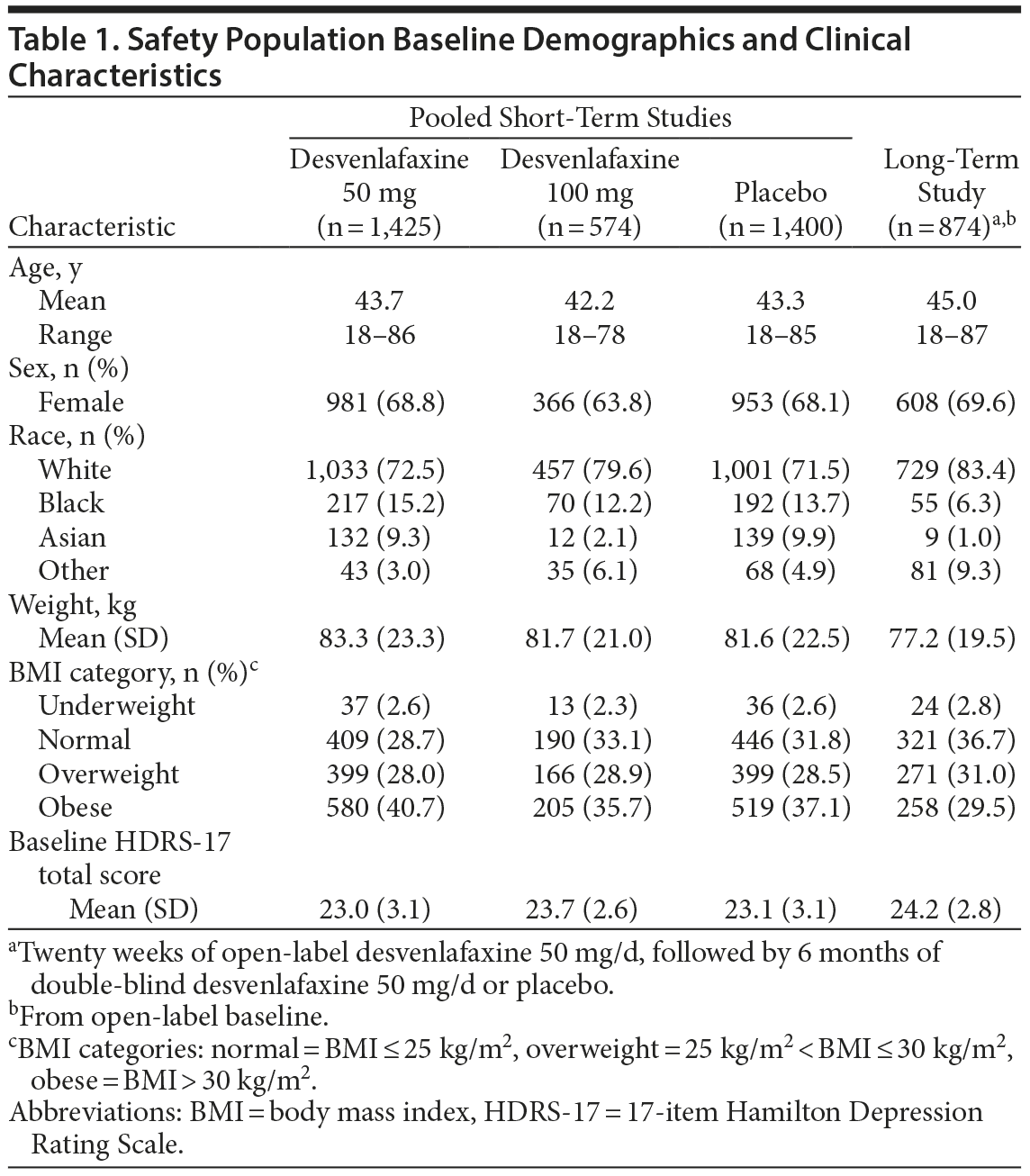
Efficacy
The HDRS-17 total scores improved significantly from baseline to week 8 (LOCF) for desvenlafaxine 50 mg/d and 100 mg/d compared with placebo for all BMI subgroups (all P ≤ .0027, Figure 1). The adjusted mean difference (95% CI) from placebo at week 8 (LOCF) ranged from –1.99 (–3.29 to –0.69, P = .0027) for the obese group to –2.24 (–3.46 to –1.01, P = .0003) for the normal group at the desvenlafaxine 100-mg/d dose, and from –1.54 (–2.39 to –0.69, P = .0004) for the obese group to –2.02 (–3.02 to –1.03, P < .0001) for the overweight group at the desvenlafaxine 50-mg/d dose.
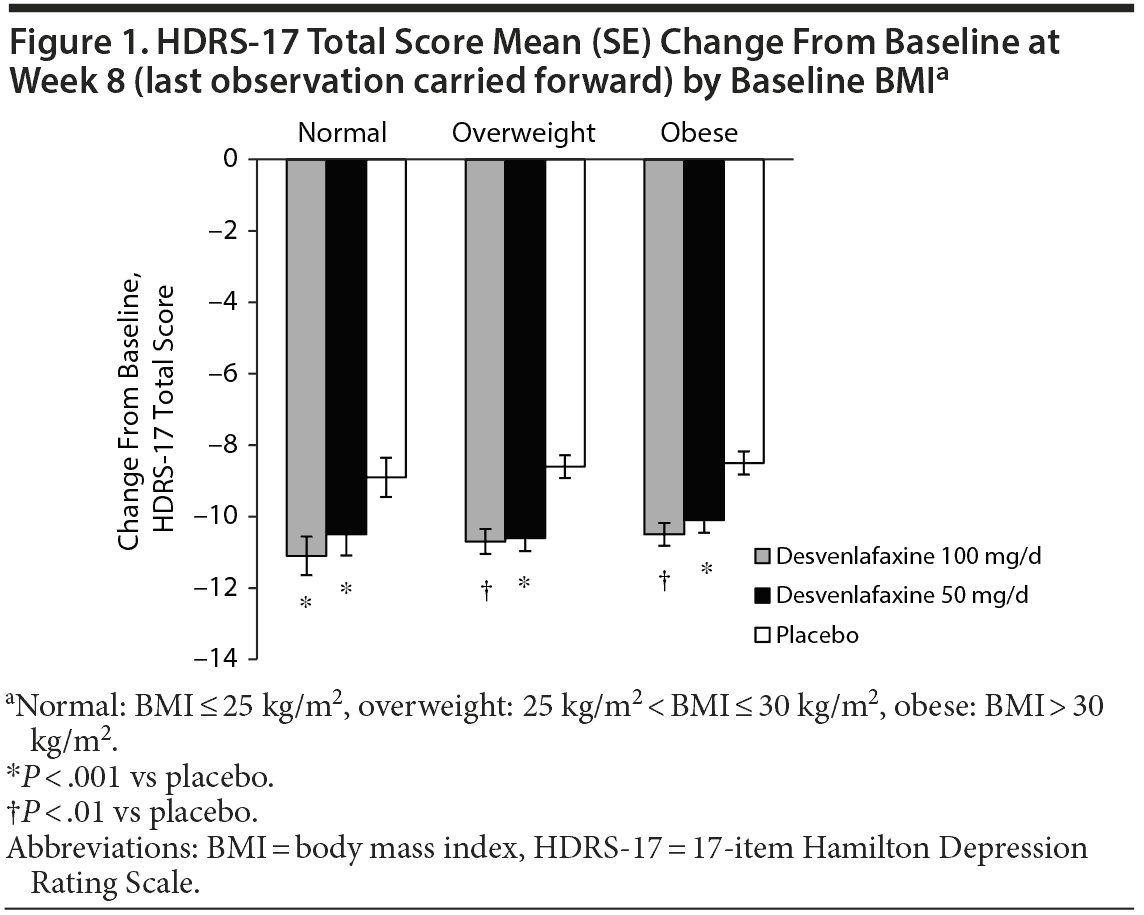
Desvenlafaxine treatment (50 mg/d and 100 mg/d) was associated with significant improvement from baseline compared with placebo on the MADRS and CGI-S scales for all BMI groups (Table 2). Significant improvement with desvenlafaxine versus placebo was also observed on the SDS and WHO-5 scales overall and for all subgroups except for overweight patients in the 100-mg/d group on the SDS and normal BMI patients in the 100-mg/d group and overweight patients in the 50-mg/d group on the WHO-5. Response rates based on HDRS-17 scores were significantly higher at week 8 (LOCF) for both desvenlafaxine doses compared with placebo for each BMI subgroup (Table 2). For normal BMI and obese patients, but not overweight patients, HDRS-17 remission rates at week 8 (LOCF) were significantly higher for desvenlafaxine compared with placebo (Table 2). Results for MADRS response and remission were similar, except the remission rate in obese patients treated with desvenlafaxine 100 mg/d did not reach significance (desvenlafaxine 100 mg/d: 39%, placebo: 32%, P = .059).
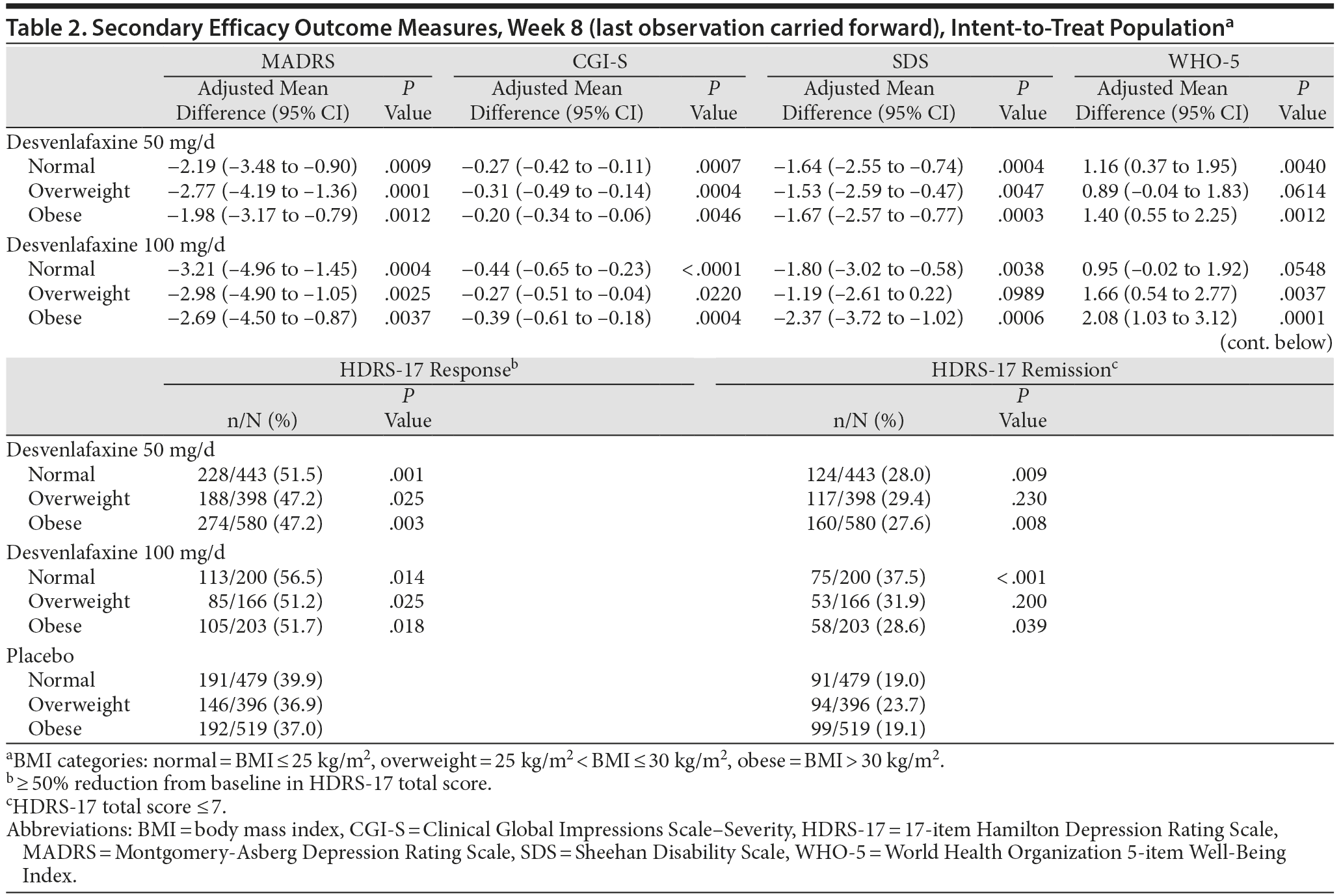
Baseline BMI was a significant predictor of change in HDRS-17 total score for the overall pooled population (P = .0022). Baseline BMI predicted change in HDRS-17 total score (higher baseline BMI, smaller change) for the desvenlafaxine 50-mg/d (P = .048) and 100-mg/d (P = .031) groups, but not for placebo (P = .097). Baseline BMI was also a significant predictor of HDRS-17 response overall (P = .0194) and for the desvenlafaxine 50-mg/d group (P = .0397): patients with higher BMI were less likely to be responders compared with patients with lower BMI. Baseline BMI was not a significant predictor of remission or time to response.
Mean Weight Change
In each of the BMI subgroups, small but significant adjusted mean decreases in weight from baseline were observed with desvenlafaxine 50-mg/d and 100-mg/d treatment compared with placebo at week 8 (observed cases) and at final on-therapy evaluation (week 8, LOCF) in the pooled short-term studies (all P ≤ .0195, Figure 2). These small reductions in weight were not clinically meaningful. In the mixed-effects model for repeated measures analysis, placebo-treated patients in the normal and overweight subgroups had small but statistically significant mean weight gain over time (adjusted mean ± SE: +0.18 ± 0.07 kg and + 0.21 ± 0.09 kg, respectively, both P ≤ .0159), and no statistically significant weight change was observed in placebo-treated obese patients (–0.08 ± 0.09 kg). The adjusted mean ± SE change in mean weight over time associated with desvenlafaxine treatment was smallest for the normal BMI group (desvenlafaxine 50 mg/d: –0.19 ± 0.06 kg, 100 mg/d: –0.36 ± 0.09 kg, both P < .0001), and largest for the obese group (desvenlafaxine 50 mg/d: –0.51 ± 0.07 kg, 100 mg/d: –0.73 ± 0.12 kg, both P < .0001). For overweight patients, the adjusted mean change in mean weight over time was –0.41 ± 0.07 kg and –0.41 ± 0.11 kg for the desvenlafaxine 50-mg/d and 100-mg/d groups, respectively (both P < .0001). Baseline BMI was a significant predictor of change in weight and BMI for the overall population (both P ≤ .0035) and for the desvenlafaxine 100-mg/d group (both P ≤ .0354). Higher baseline BMI was associated with greater short-term (8-week) weight loss, particularly in the desvenlafaxine 100-mg/d group. Statistically significant weight loss was observed at week 8 (LOCF) for both desvenlafaxine doses compared with placebo in responders, nonresponders, and nonremitters (all P ≤ .0018). In remitters, statistically significant weight change versus placebo was observed in patients treated with desvenlafaxine 100 mg/d (P = .0005)—but not 50 mg/d.
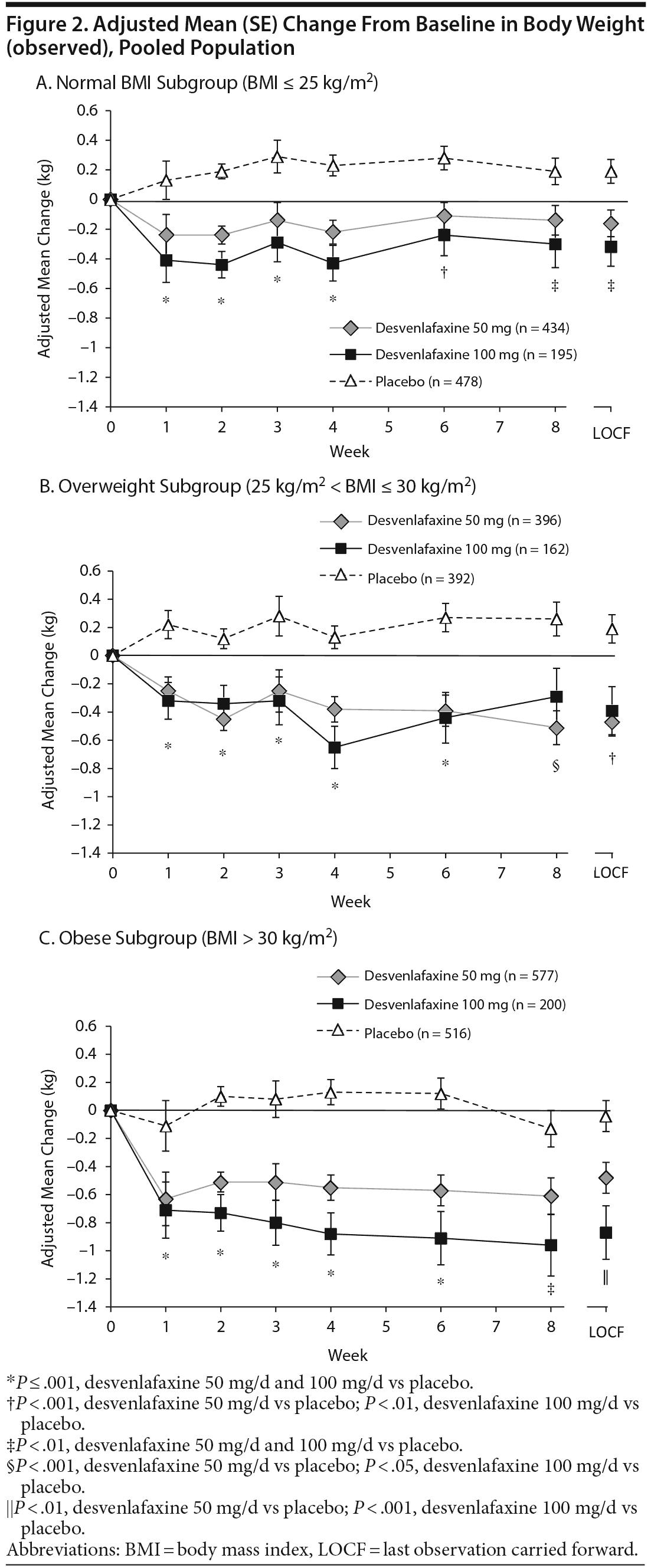
In the randomized withdrawal study, open-label desvenlafaxine 50 mg/d was associated with a transient mean decrease in weight followed by an increase of 0.47 kg from baseline in the open-label period (Figure 3A). During double-blind treatment (after 20-week open-label desvenlafaxine 50 mg/d), treatment with desvenlafaxine 50 mg/d resulted in significantly less mean weight gain over time versus placebo overall (0.24 kg vs + 0.52 kg, respectively, P = .004, Figure 3B). No statistically significant change from baseline was observed in the normal and overweight subgroups after 8-week open-label treatment with desvenlafaxine 50 mg/d, but a mean change of –0.38 ± 0.15 kg was observed in obese patients (P = .012 vs baseline, Figure 4A). Weight increased significantly with desvenlafaxine treatment versus baseline at open-label week 20 in the normal and overweight subgroups (0.67 ± 0.18 kg and 0.58 ± 0.19 kg, respectively, both P ≤ .003), but not in the obese subgroup (Figure 4A). After 26 weeks of double-blind treatment with desvenlafaxine 50 mg/d (study week 46), desvenlafaxine-treated patients in the normal BMI subgroup, but not the overweight or obese subgroups, had a statistically significant increase in weight from double-blind baseline (0.97 ± 0.26 kg, P < .001). However, no statistically significant differences between desvenlafaxine-treated patients and placebo-treated patients who had previously received open-label desvenlafaxine treatment were observed in any BMI subgroup (Figure 4B). Baseline BMI was a significant predictor of change in weight and BMI for the overall population (both P ≤ .009) and for the desvenlafaxine 50-mg/d group (both P ≤ .0112) in the randomized withdrawal study. Patients with higher baseline BMI, and the obese group in particular, had smaller weight gain longer-term.
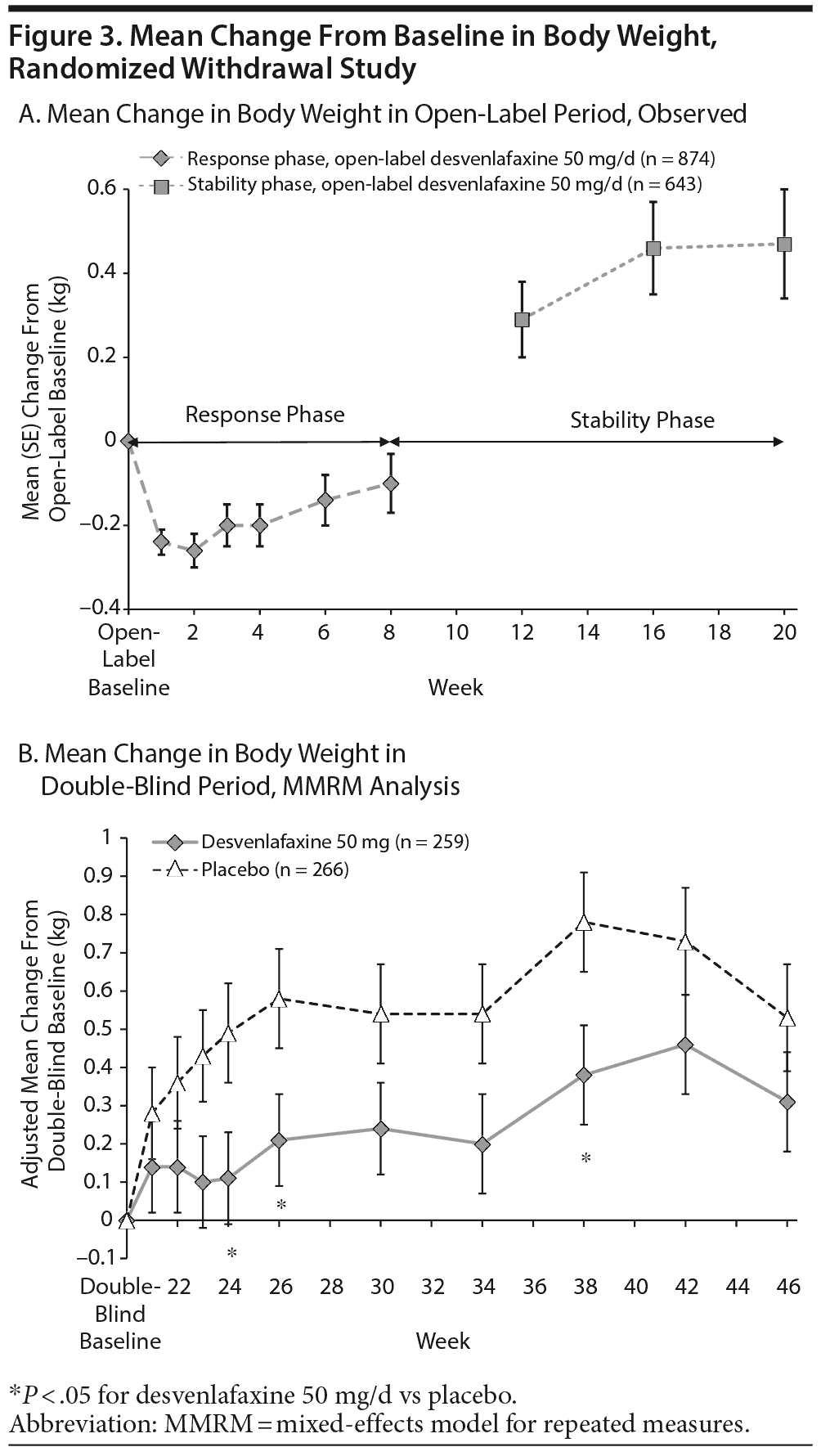
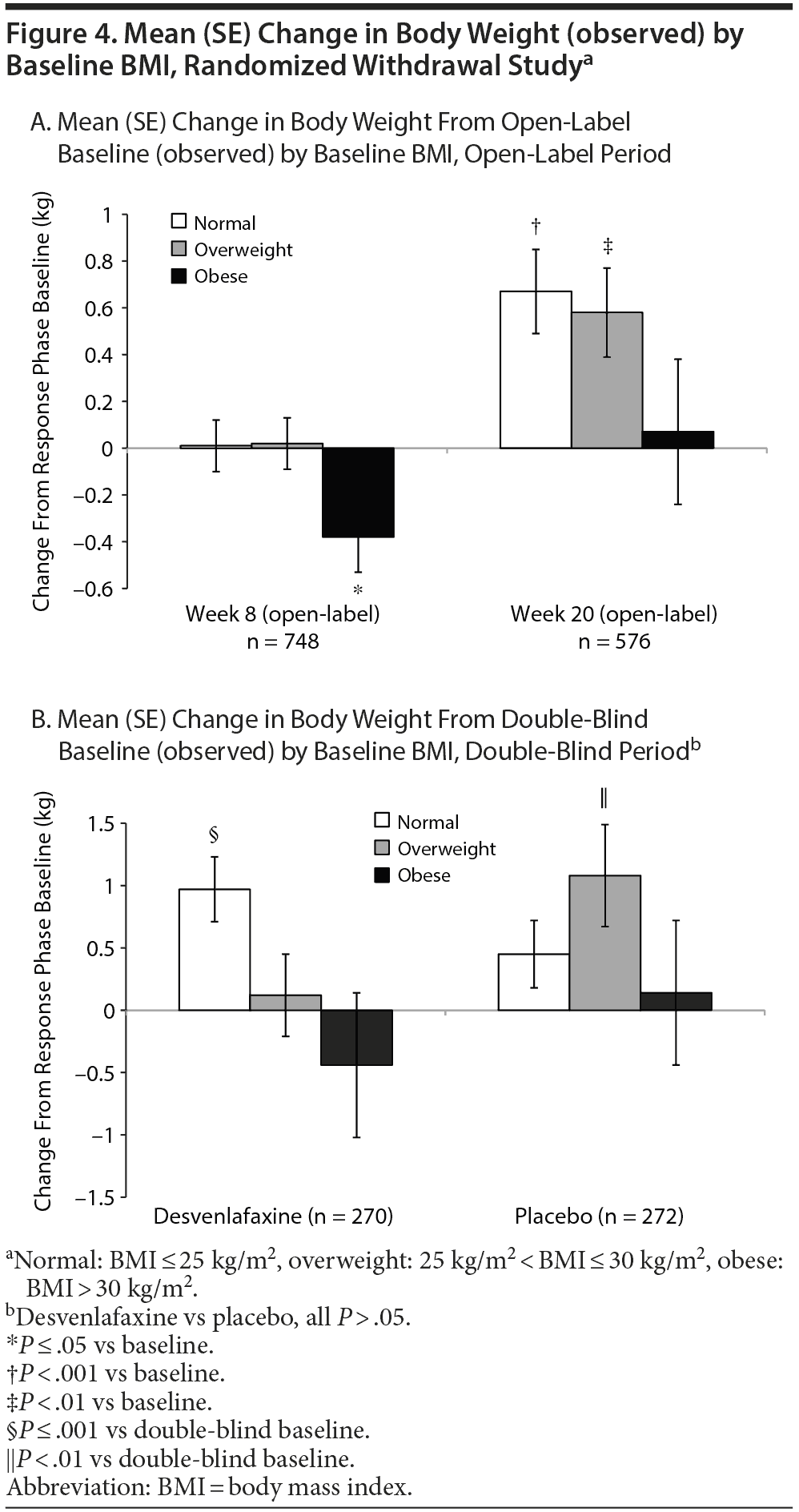
Clinically Meaningful Weight Change
Obese patients generally had the highest rates of clinically meaningful decreases in weight (≥ 7% decrease from baseline) and lowest rates of clinically meaningful increases (≥ 7% increase from baseline) both short-term and longer-term. In the pooled short-term studies, rates of clinically meaningful decreases in weight were 1.6%, 1.5%, and 1.2% for desvenlafaxine 50-mg/d–treated patients and 1.0%, 1.9%, and 3.0% for desvenlafaxine 100-mg/d–treated patients in the normal, overweight, and obese subgroups, respectively (placebo: 0.4%, 0.5%, and 0.8%, respectively). In these same subgroups, clinically meaningful increases in weight were reported in 0.9%, 1.3%, and 0.4% of desvenlafaxine 50-mg/d–treated patients and 1.0%, 0.6%, and 0% of desvenlafaxine 100-mg/d–treated patients, respectively (placebo: 1.0%, 0.3%, and 0%, respectively). In the randomized withdrawal study, rates of clinically meaningful increases in weight in the normal, overweight, and obese subgroups were 3.9%, 3.0%, and 7.4%, respectively, among desvenlafaxine 50-mg/d–treated patients, and 1.9%, 2.4%, and 6.1%, respectively, among placebo-treated patients. In these same subgroups, clinically meaningful increases in weight were reported in 15.7%, 10.0%, and 5.9% of desvenlafaxine 50-mg/d–treated patients and 7.6%, 10.7%, and 6.1% of placebo-treated patients. One patient in the pooled short-term population discontinued treatment due to increased weight (obese, placebo group). One patient each discontinued from the open-label response and stability phases of the randomized withdrawal study due to increased weight, both obese at baseline; no patients in the double-blind phase discontinued due to increased weight. No patients in the pooled short-term population or the randomized withdrawal study discontinued due to weight loss.
DISCUSSION
The notably high percentage of overweight (28.4%) and obese (38.4%) patients in this pooled study population (an aggregate of 66.7%) highlights the importance of possibly considering BMI in antidepressant treatment selection. In this analysis, there was statistically significant improvement from baseline in the primary efficacy endpoint for both desvenlafaxine doses compared with placebo for all BMI subgroups. Nonetheless, baseline BMI was a significant predictor of change in HDRS-17 total score overall and for the 2 desvenlafaxine dose groups; the smallest effect size at both desvenlafaxine doses was observed in the obese subgroup. Results for secondary outcomes were generally statistically significant for each BMI subgroup, although there were a few results that were not, particularly for the overweight group. The current results are in line with the findings of several published studies. Obese patients tended to have a poorer response to treatment compared with normal and overweight patients in a study of outpatients treated with selective serotonin reuptake inhibitors (SSRIs),11 and in a study of inpatients treated with 1 or more antidepressant drugs, including SSRIs, mirtazapine, or tricyclic antidepressants.12 A significantly greater response to antidepressant treatment was also reported for normal weight patients compared with overweight and obese patients in a meta-analysis of 3 active-controlled trials of SSRIs and SNRIs.37 Greater baseline body weight predicted less improvement in depression scale scores among nortriptyline-treated patients (but not among escitalopram-treated patients).14 Greater baseline body weight also predicted nonresponse in depressed patients treated with fluoxetine in an 8-week open-label trial,13 and higher baseline body weight and BMI were associated with poorer improvement in depressive and functional symptoms and lower rates of remission (but not response) in a post hoc analysis of a second, 6-week open-label fluoxetine trial.38 In contrast—and consistent with results of the current analysis—BMI at admission did not predict remission in inpatients treated for depression in the naturalistic Munich Antidepressant Response Signature project.39
The changes in body weight observed in the pooled short-term studies and in the randomized withdrawal study are generally consistent with those reported for desvenlafaxine doses up to 400 mg/d,17 for the SNRIs duloxetine and venlafaxine, and for some of the SSRIs.6 In a meta-analysis6 of 116 studies assessing tricyclic antidepressant drugs, SSRIs, SNRIs, and atypical antidepressants, small but significant weight loss compared with placebo was reported during acute treatment (4–12 weeks) with duloxetine (–0.55 kg), venlafaxine (–0.50 kg), and some SSRIs (–0.94 kg [fluoxetine] to –0.28 kg [paroxetine]); weight change was not statistically significant for fluvoxamine. In longer-term studies6,10 (≥ 4 months), early weight loss was generally followed by a return to baseline weight in patients treated with duloxetine or SSRIs. The increase in weight later in treatment was significant compared with placebo for duloxetine- and paroxetine-treated patients after 32 to 34 weeks of treatment.10 The relationship between baseline BMI and weight change observed in this analysis (patients with higher baseline BMI had greater weight loss early in treatment and smaller weight gain longer-term) has also been reported with other antidepressant drugs.9,10
A limitation of this pooled, post hoc analysis is that study designs varied across the pooled studies, and the study population was not uniform; in particular, 1 study population comprised perimenopausal and postmenopausal women only. None of the studies were designed to assess weight as a primary outcome. Results cannot be generalized to patients excluded from the pooled studies, including patients with any unstable hepatic, renal, pulmonary, cardiovascular (including uncontrolled hypertension), or other medical condition.
CONCLUSIONS
The approved desvenlafaxine doses of 50 mg/d and 100 mg/d effectively reduced the symptoms of depression regardless of BMI at baseline. Baseline BMI was, however, a significant predictor of response in desvenlafaxine-treated patients: slightly greater improvement in depressive symptoms was observed in the normal BMI subgroup. Desvenlafaxine treatment for MDD was associated with a significant, but not clinically relevant, mean weight loss (< 1 kg) compared with placebo regardless of BMI category in the pooled, short-term studies. Weight loss was significantly predicted by baseline BMI and largest in obese patients. Longer-term weight changes during treatment with desvenlafaxine 50 mg/d were also predicted by baseline BMI. Lower baseline weight and BMI were associated with a greater increase in weight during longer-term treatment; no statistically significant change from baseline weight was observed in overweight or obese patients.
Drug names: desvenlafaxine (Pristiq), duloxetine (Cymbalta), escitalopram (Lexapro and others), fluoxetine (Prozac and others), fluvoxamine (Luvox and others), mirtazapine (Remeron and others), nortriptyline (Pamelor, Aventyl, and others), paroxetine (Paxil, Pexeva, and others), venlafaxine (Effexor and others).
Author affiliations: Department of Psychiatry and Pharmacology, University of Toronto and Mood Disorders Psychopharmacology Unit, University Health Network,Toronto, Ontario, Canada (Dr McIntyre); Pfizer Inc, New York, New York (Dr Fayyad); Pfizer Inc, Collegeville, PA (Dr Guico-Pabia); and Pfizer Canada Inc, Kirkland, Quebec (Dr Boucher). Dr Guico-Pabia is now with CGP Strategic Solutions, LLC, Lansdale, Pennsylvania.
Potential conflicts of interest: Dr McIntyre has received research grants from AstraZeneca, Eli Lilly, Janssen-Ortho, Lundbeck, Pfizer, and Shire; has participated on advisory boards for AstraZeneca, Bristol-Myers Squibb, Eli Lilly, France Foundation, GlaxoSmithKline, Janssen-Ortho, Merck, Organon, Lundbeck, Pfizer, and Shire and speakers bureaus for AstraZeneca, Eli Lilly, Janssen-Ortho, Lundbeck, Merck, and Pfizer; and has participated in CME activities with AstraZeneca, Bristol-Myers Squibb, CME Outfitters, Eli Lilly, France Foundation, Merck, I3CME, Optum Health, Pfizer, Physicians Postgraduate Press. Drs Fayyad and Boucher are employes of and stock shareholders in Pfizer. Dr Guico-Pabia is a former employee of and stock shareholder in Pfizer.
Funding/support: This study was sponsored by Pfizer.
Role of the sponsor: The sponsor contributed to the design and conduct of the study, collection and analysis of data, and review of the manuscript. The authors were responsible for the interpretation of the data, the final content of the manuscript, and the decision to submit for publication.
Previous presentations: Data in this manuscript were presented as a poster at the United States Psychiatric and Mental Health Congress, San Diego, California, November 8–11, 2012, and the American Psychiatric Association Annual Meeting, San Francisco, California, May 18–22, 2013.
Acknowledgments: Medical writing support was provided by Kathleen Dorries, PhD, and Callie Grimes, PhD (Peloton Advantage, LLC, Parsippany, NJ), and was funded by Pfizer. Drs Dorries and Grimes report no other conflicts of interest related to the subject of this article.
REFERENCES
1. McIntyre RS, Konarski JZ, Wilkins K, et al. Obesity in bipolar disorder and major depressive disorder: results from a national community health survey on mental health and well-being. Can J Psychiatry. 2006;51(5):274–280. PubMed
2. McIntyre RS, Alsuwaidan M, Goldstein BI, et al; Canadian Network for Mood and Anxiety Treatments (CANMAT) Task Force. The Canadian Network for Mood and Anxiety Treatments (CANMAT) task force recommendations for the management of patients with mood disorders and comorbid metabolic disorders. Ann Clin Psychiatry. 2012;24(1):69–81. PubMed
3. Luppino FS, de Wit LM, Bouvy PF, et al. Overweight, obesity, and depression: a systematic review and meta-analysis of longitudinal studies. Arch Gen Psychiatry. 2010;67(3):220–229. doi:10.1001/archgenpsychiatry.2010.2 PubMed
4. de Wit L, Luppino F, van Straten A, et al. Depression and obesity: a meta-analysis of community-based studies. Psychiatry Res. 2010;178(2):230–235. doi:10.1016/j.psychres.2009.04.015 PubMed
5. Pan A, Sun Q, Czernichow S, et al. Bidirectional association between depression and obesity in middle-aged and older women. Int J Obes (Lond). 2012;36(4):595–602. doi:10.1038/ijo.2011.111 PubMed
6. Serretti A, Mandelli L. Antidepressants and body weight: a comprehensive review and meta-analysis. J Clin Psychiatry. 2010;71(10):1259–1272. doi:10.4088/JCP.09r05346blu PubMed
7. Hasnain M, Vieweg WV, Hollett B. Weight gain and glucose dysregulation with second-generation antipsychotics and antidepressants: a review for primary care physicians. Postgrad Med. 2012;124(4):154–167. doi:10.3810/pgm.2012.07.2577 PubMed
8. Cassano P, Fava M. Tolerability issues during long-term treatment with antidepressants. Ann Clin Psychiatry. 2004;16(1):15–25. doi:10.1080/10401230490281618 PubMed
9. Uher R, Mors O, Hauser J, et al. Changes in body weight during pharmacological treatment of depression. Int J Neuropsychopharmacol. 2011;14(3):367–375. doi:10.1017/S1461145710000933 PubMed
10. Wise TN, Perahia DG, Pangallo BA, et al. Effects of the antidepressant duloxetine on body weight: analyses of 10 clinical studies. Prim Care Companion J Clin Psychiatry. 2006;8(5):269–278. doi:10.4088/PCC.v08n0503 PubMed
11. Khan A, Schwartz KA, Kolts RL, et al. BMI, sex, and antidepressant response. J Affect Disord. 2007;99(1–3):101–106. doi:10.1016/j.jad.2006.08.027 PubMed
12. Kloiber S, Ising M, Reppermund S, et al. Overweight and obesity affect treatment response in major depression. Biol Psychiatry. 2007;62(4):321–326. doi:10.1016/j.biopsych.2006.10.001 PubMed
13. Papakostas GI, Petersen T, Iosifescu DV, et al. Obesity among outpatients with major depressive disorder. Int J Neuropsychopharmacol. 2005;8(1):59–63. doi:10.1017/S1461145704004602 PubMed
14. Uher R, Mors O, Hauser J, et al. Body weight as a predictor of antidepressant efficacy in the GENDEP project. J Affect Disord. 2009;118(1-3):147–154. doi:10.1016/j.jad.2009.02.013 PubMed
15. Pristiq [package insert]. Philadelphia, PA: Wyeth Pharmaceuticals, Inc, a subsidiary of Pfizer Inc; 2013.
16. Pristiq
17. Tourian KA, Leurent C, Graepel J, et al. Desvenlafaxine and weight change in major depressive disorder. Prim Care Companion J Clin Psychiatry. 2010;12(1):e1–e8. PubMed
18. DeMartinis NA, Yeung PP, Entsuah R, et al. A double-blind, placebo-controlled study of the efficacy and safety of desvenlafaxine succinate in the treatment of major depressive disorder. J Clin Psychiatry. 2007;68(5):677–688. doi:10.4088/JCP.v68n0504 PubMed
19. Liebowitz MR, Manley AL, Padmanabhan SK, et al. Efficacy, safety, and tolerability of desvenlafaxine 50 mg/day and 100 mg/day in outpatients with major depressive disorder. Curr Med Res Opin. 2008;24(7):1877–1890. doi:10.1185/03007990802161923 PubMed
20. Boyer P, Montgomery S, Lepola U, et al. Efficacy, safety, and tolerability of fixed-dose desvenlafaxine 50 and 100 mg/day for major depressive disorder in a placebo-controlled trial. Int Clin Psychopharmacol. 2008;23(5):243–253. doi:10.1097/YIC.0b013e32830cebed PubMed
21. Tourian KA, Padmanabhan SK, Groark J, et al. Desvenlafaxine 50 and 100 mg/d in the treatment of major depressive disorder: an 8-week, phase III, multicenter, randomized, double-blind, placebo-controlled, parallel-group trial and a post hoc pooled analysis of three studies. Clin Ther. 2009;31(pt 1):1405–1423. doi:10.1016/j.clinthera.2009.07.006 PubMed
22. Iwata N, Tourian KA, Hwang E, et al, for the Study 3359 Investigators. Efficacy and safety of desvenlafaxine 25 and 50 mg/day in a randomized, placebo-controlled study of depressed outpatients. J Psychiatr Pract. 2013;19(1):5–14. doi:10.1097/01.pra.0000426323.59698.64 PubMed
23. Liebowitz MR, Tourian KA, Hwang E, et al; Study 3362 Investigators. A double-blind, randomized, placebo-controlled study assessing the efficacy and tolerability of desvenlafaxine 10 and 50 mg/day in adult outpatients with major depressive disorder. BMC Psychiatry. 2013;13(1):94. doi:10.1186/1471-244X-13-94 PubMed
24. Clayton AH, Kornstein SG, Dunlop BW, et al. Efficacy and safety of desvenlafaxine 50 mg/d in a randomized, placebo-controlled study of perimenopausal and postmenopausal women with major depressive disorder. J Clin Psychiatry. 2013;74(10):1010–1017. doi:10.4088/JCP.12m08065 PubMed
25. Dunlop BW, Reddy S, Yang L, et al. Symptomatic and functional improvement in employed depressed patients: a double-blind clinical trial of desvenlafaxine versus placebo. J Clin Psychopharmacol. 2011;31(5):569–576. doi:10.1097/JCP.0b013e31822c0a68 PubMed
26. Rosenthal JZ, Boyer P, Vialet C, et al. Efficacy and safety of desvenlafaxine 50 mg/d for prevention of relapse in major depressive disorder: a randomized controlled trial. J Clin Psychiatry. 2013;74(2):158–166. doi:10.4088/JCP.12m07974 PubMed
27. Hamilton M. A rating scale for depression. J Neurol Neurosurg Psychiatry. 1960;23(1):56–62. doi:10.1136/jnnp.23.1.56 PubMed
28. American Psychiatric Association. Diagnostic and Statistical Manual of Mental Disorders, Fourth Edition. Washington, DC: American Psychiatric Association; 1994.
29. American Psychiatric Association. Diagnostic and Statistical Manual of Mental Disorders, Fourth Edition, Text Revision. Washington, DC: American Psychiatric Association; 2000.
30. Montgomery SA, Asberg M. A new depression scale designed to be sensitive to change. Br J Psychiatry. 1979;134(4):382–389.
31. Guy W. ECDEU Assessment Manual for Psychopharmacology–Revised. Rockville, MD: National Institute of Health, Department of Health, Education, and Welfare; 1976. doi:10.1192/bjp.134.4.382 PubMed GuyGuy W. ECDEGGGGGGjjjjjjkU Assessment Mdanual for Psychopharmacology–Revised. RGuy W. ECDEGuy W. ECDEU Assessment Manual for Psychopharmacology–Revised. Rockville, MD: National Institute of Health, Department of Health, Education, andddddddd Welfare; 1976.U Assessment Manual for Psychopharmacology–Revised. RoGuy W. ECDEU Assessment Manual for Psychopharmacology–Revised. Rossssssckville, MD: National Institute of Health, Department of Health, Education, and Welfare; 1976.ckville, MD: National Institute of Health, Department of Health, Education, and Welfare; 1976.ockdvGgille, MD: National Institute of Health, DepartmGuy W. ECDEU Assessment Manual for Psychopharmacology–Revised. Rockville, MD: National Institute of Health, Department of Health, Education, and Welfare; 1976.ent of Health, Education, and Welfare; 1976.Guy W. ECDEU Assessment Manual for Psychopharmacology–Revised. Rockville, MD: National Institute of Health, Department of Health, Education, and Welfare; 1976.Guy W. ECDEU Assessment MGuy W. ECDEU Assessment Manual for Psychopharmacology–Revised. Rockville, MD: National Institute of Health, Department of Health, Education, and Welfare; 1976.anual for PsychopharmacologGuy W. ECDEU Assessment Manual for Psychopharmacology–Revised. Rockville, MD: National Institute of Health, Department of Health, Education, and Welfare; 1976.–Revised. RockvGuy W. ECDEU Assessment Manual for Psychopharmacology–Revised. Rockville, MD: National Institute of Health, Department of Health, Education, and Welfare; 1976.ille, MD: National Institute of Health, Department of Health, Education, and Welfare; 1976. Guy W. ECDEU Assessment Manual for Psychopharmacology–Revised. Rockville, MD: National Institute of Health, Department of Health, Education, and Welfare; 1976. Guy W. ECDEU Assessment Manual for Psychopharmacology–Revised. Rockville, MD: National Institute of Health, Department of Health, Education, and Welfare; 1976.ddddd
32. Sheehan DV. Sheehan Disability Scale. In: Rush AJ, Pincus HA, First MB, eds. Handbook of Psychiatric Measures. Washington, DC: American Psychiatric Association; 2000:113–115.
33. World Health Organization. Wellbeing measures in primary health care/the depcare project. World Health Organization Regional Office for Europe. http://www.euro.who.int/__data/assets/pdf_file/0016/130750/E60246.pdf. Accessed March 20, 2012.
34. Hirschfeld RM, Montgomery SA, Aguglia E, et al. Partial response and nonresponse to antidepressant therapy: current approaches and treatment options. J Clin Psychiatry. 2002;63(9):826–837. doi:10.4088/JCP.v63n0913 PubMed
35. Frank E, Prien RF, Jarrett RB, et al. Conceptualization and rationale for consensus definitions of terms in major depressive disorder: remission, recovery, relapse, and recurrence. Arch Gen Psychiatry. 1991;48(9):851–855. doi:10.1001/archpsyc.1991.01810330075011 PubMed
36. Hawley CJ, Gale TM, Sivakumaran T; Hertfordshire Neuroscience Research group. Defining remission by cutoff score on the MADRS: selecting the optimal value. J Affect Disord. 2002;72(2):177–184. doi:10.1016/S0165-0327(01)00451-7 PubMed
37. Oskooilar N, Wilcox CS, Tong ML, et al. Body mass index and response to antidepressants in depressed research subjects. J Clin Psychiatry. 2009;70(11):1609–1610. doi:10.4088/JCP.09l05226blu PubMed
38. Lin CH, Chen CC, Wong J, et al. Both body weight and BMI predicts improvement in symptom and functioning for patients with major depressive disorder. J Affect Disord. 2014;161:123–126. doi:10.1016/j.jad.2014.02.039 PubMed
39. Hennings JM, Owashi T, Binder EB, et al. Clinical characteristics and treatment outcome in a representative sample of depressed inpatients: findings from the Munich Antidepressant Response Signature (MARS) project. J Psychiatr Res. 2009;43(3):215–229. doi:10.1016/j.jpsychires.2008.05.002 PubMed
Please sign in or purchase this PDF for $40.00.

